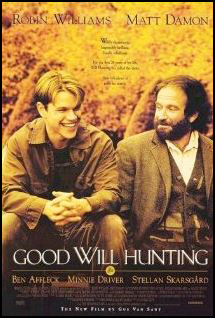A few days have passed now, giving the tragic reality time to sink in more deeply – Robin Williams is dead. On the first day or two, many of us searched the Internet, looking for details, hoping for some understanding. Now we know more details, but can only guess at the magnitude of pain and despair that moved him to find suicide as his ultimate or best alternative.
One of Robin’s greatest gifts was his ability to bravely dive into the immense depth of the human emotional experience to bring life and grace to human disparity, compassion, imagination, humor, and despair. We, his audience, rode along with him into emotional territory we may not have braved on our own.
The year was 1997. Robin’s movie, Good Will Hunting, had recently opened to major acclaim. There was a general buzz about the film, but perhaps most intrigued were the community of mental health professionals. All of Robin’s characters stretched boundaries in one way or another. As Will’s (Matt Damon’s) therapist, Sean Maguire, he pushed into territory we therapists know so well and he did it with an essence of nuanced genius. On the screen before us, we saw him not only break the taboo of touch in psychotherapy: we saw a client and his therapist hold each other with full bodies pressed for as long as the client needed and as long as the client was sobbing. We even saw Robin stand on his tiptoes in order to do it. There were other beautiful examples of what we have been categorically taught in our risk management workshops are boundary violations to be avoided under any circumstance. Yet, as depicted on screen, they were clearly experienced by client, therapist and (most) audiences as beneficial interventions (i.e., helpful boundary crossings).
We saw Robin, the tiptoe-stander, move in close to “get in his client’s face” to help him stop taking responsibility for his father’s violent and abusive behavior. We watched shocked, as he did not shy away when Matt Damon physically tried to shove him off. Instead, he stayed lovingly and supportively in close proximity, creating a safe place for his client’s anger and internalized rage to be transformed to grief and tears. We heard multiple instances of the therapist’s (Williams’) extensive and intimate self-disclosures that were perfectly placed therapeutically, and many more engaging examples of helpful boundary crossings.
Here is a sample clip from the movie Good Will Hunting that displays several boundary crossings, such as extensive and effective self-disclosure, space/proximity (therapist gets in client’s face), physical contact (holding a sobbing client), and much more.
In a way, actors and therapists respond to a similar call. We are both called to build a dynamic system of our own emotional regulation that is large enough for us to connect with the huge diversity of human emotional experience while being able to hold to our core strength. Robin demonstrated this time and again. As therapists, we need to support one another in exploring an element of intuition that can help us aid the client and help healing. Part of Robin’s legacy is that he has moved people to try to better understand depression and other mental conditions. His big heart brought that to us as well as so much else. We wish peace to his Spirit and comfort to those who grieve.
